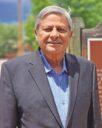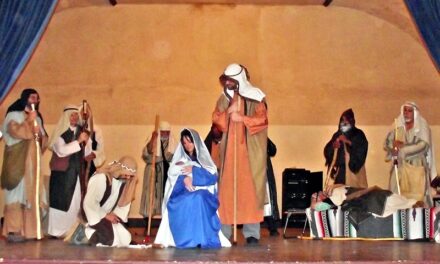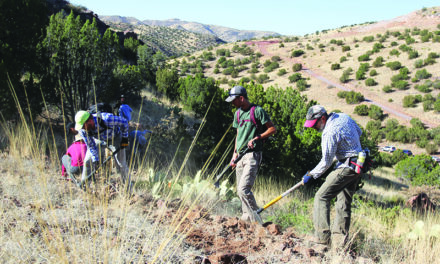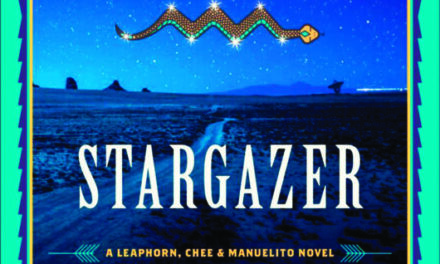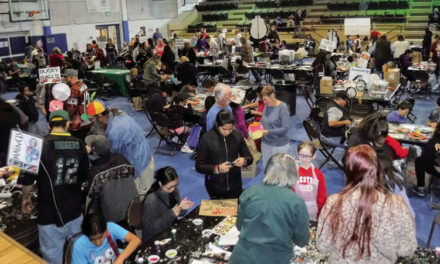
Guitarist Neil Haverstick performs with Blue Monday on Friday night at the Capitol Bar.
Cathy Cook | El Defensor Chieftain photos
When a new guitarist picks up their instrument for the first time, they usually think about learning scales, chords or new songs, not about how those scales and chords were created and what other tonal systems might exist.
If you’re interested in music, math or physics, guitarist Neil Haverstick’s workshop on microtonal music might be for you. The free workshop, set for Tuesday, Feb. 7, at noon at the Recital Hall Jean Macey Annex, will explore alternate tuning systems and the concept of microtonal music.
“Microtone means a tone smaller than a fret on a guitar, smaller than that,” said Haverstick. “The problem is, this gets a little tricky, that kind of implies that the European tone is the standard. It’s not. We’re the new guy on the block. Nobody played 12-tone equal temperament in any culture in the world, but we don’t know that.”
With 11 albums to his name, Haverstick has been a guitarist for over 50 years. He bought his first guitar at 14 years old for $3, and has built a career as a free-lance guitarist, picking up gigs in all kinds of genres—country, blues, jazz and classical guitar. He’s played with the Colorado Symphony in Denver and had quite a few theater pit gigs in Colorado, but at heart he’s a composer passionate about microtonal music.
“I play blues. I play everything, but this is what I really do—move music forward.”
Haverstick has written two books on microtonal music and has a collection of instruments with alternate tunings, including 19, 24 and even 36-tone guitars.
“That’s a lot of frets. Then I’ve got saz, fretless banjo, several fretless guitars that I’ll be playing at the seminar.”
The Turkish saz is a long-necked lute used in Turkish, Kurdish and Armenian music. The instrument traditionally uses a different musical scale than western instruments.
“When you study the tunings of another culture, you’re actually studying the culture. Let’s say you’re studying oud in Iraq. Well, they play for weddings, they play for parties, so what songs did they write? Now you’re into their culture.
“Everybody gets married. Everybody has a party. So, if I’m playing guitar over here, some guy in Iraq two thousand years ago might have been playing oud for the emperor’s wedding, so now you’re into their songs and their myths and their history.”

Bass player Jim Ruff (right) leans over to talk to guitarist Neil Haverstick during their gig at the Capitol Bar Friday night.
Fretless guitars or banjos allow the musician to play any note they want.
“I’ve seen people do stuff on fretless that would make your jaw drop,” said Haverstick.
Haverstick grew up listening to bands like The Beatles and the Yardbirds, inspiring his passion for guitar.
“The Beatles, they’re number one, but the Yardbirds may have been the second most important rock band in history. Eric Clapton was in them, and Jeff Beck and Jimmy Page, who went on to start Led Zeppelin.
“When I was a kid, it was in 1966, so it was 57 years in the spring, I turned on the radio, and I heard a Yardbirds tune by accident called “Over Under Sideways Down.” I didn’t know it was a guitar. It sounded like an Arabic fiddle or something, and I said what the hell is this?”
Even though he’d only been playing guitar for eight months, after hearing the Yardbirds Haverstick knew that’s what he wanted to do.
“That whole 60s thing was really as good as advertised. It’s not nostalgia. Things happened that have not happened since. The Beatles brought the sitar in, so you’re listening to Ravi Shankar as a 16-year-old and being exposed to Indian music. So, we start looking into Indian music. So, I’m looking into that, and the Doors, they did a tune that had flamenco guitar in it. I played flamenco later.”
Haverstick played a lot of music later. He played and studied guitar with blues musicians in Kansas, country and jazz musicians in Denver, and even had a chance to meet one of the great studio guitar players, Tommy Tedesco, in the early 80s on a visit to Los Angeles.
But rising rents in Denver inspired Haverstick to relocate in Socorro last year.
“I had no idea of all the good musicians here. Capitol is one of the best clubs I’ve played in my career,” he said.
Haverstick has had 14 gigs at the Capitol Bar since he arrived in August and plays in two local bands, Blue Monday and Pepper Jam, but he considers himself semi-retired.
“I’m not trying to get a blues career going. I’m just having a hoot, but this, I’m still on. If something would ever come of my tuning adventures, I’m pretty happy with that.”
Haverstick would like to see a famous guitarist record an album in a different tuning system, like 19-tone equal temperament, and inspire kids’ curiosity just like the Yardbirds inspired his.




